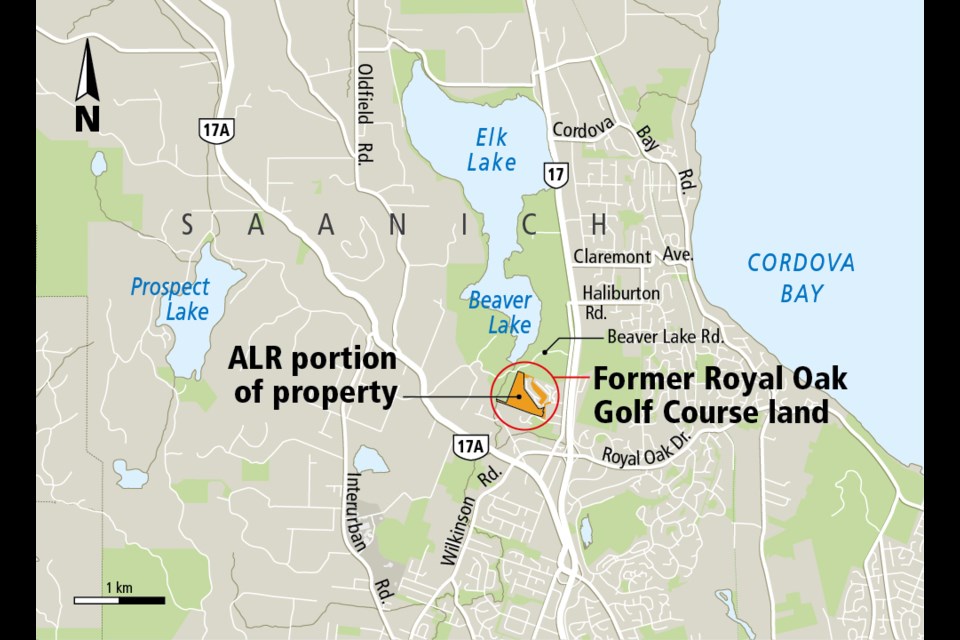Saanich residents are worried they could lose green space and potential agricultural land to development if a landowner’s application to remove the land from agricultural protection is successful.
The owner of the nearly 11-hectare former Royal Oak Golf Course land, just south of Elk/Beaver Lake Regional Park, has applied to exclude the property from the provincial Agricultural Land Reserve, which could open the door to development. About two hectares of the property are not part of the Agricultural Land Reserve.
Saanich council will consider a report prepared by staff recommending that it encourage the Agricultural Land Commission to reject the application. The report will go to Saanich’s committee of the whole on Oct. 28.
In the report, staff note that many residents have submitted letters and petitions mostly in opposition to the former golf course’s exclusion from the land reserve, citing concerns about loss of agricultural land and green space.
As president of the Royal Oak Community Association, Roger Graham has heard from many residents who live close to the land . He said the majority want the land to remain protected as agricultural land, so it can be used for farming or be acquired by the municipality as an extension of the nearby park. The report by Saanich staff states many letters submitted by residents requested that the municipality or the CRD acquire the land for a park.
“This is agricultural land and we’ve got very little of it in Royal Oak now, or Saanich for that matter. It’s disappearing because of development,” Graham said. “Our view is to retain the agricultural-land nature of it, even if it’s not used for farming immediately. At least it’s there and available for farming.”
Applications to exclude land from the reserve are referred to local government by the commission.
Council can choose to reject the application, or forward it to the commission with or without a recommendation. If council forwards the application, even with a recommendation to reject it, the decision rests with the commission.
The owners, who have hired Four Corners Planning Group to make the application, have not indicated what they would do with the land if the application is successful.
When applicants make exclusion requests to develop land for non-farm use, it’s policy for them to file all development applications that would be necessary for their intended project.
“The land use planning component is critical to inform future policy decisions for this area of Royal Oak,” the staff report states.
Ross Blackwell, a senior planner with Four Corners Planning Group, believes this requirement is unfair.
“What may or may not happen in the future should have no bearing on whether land fits the criteria of what is and what isn't Agricultural Land Reserve land,” he said. “It’s very clear — abundantly clear — that this land is not suitable for agriculture or capable of agriculture.”
The province established the commission in 1973 to protect high-quality agricultural lands against development.
Madrone Environmental Services Ltd. prepared an assessment of the land’s capability for agricultural use for the applicant. The assessment states 70 per cent of the land has a poor capability for agriculture based on its topography and bedrock. The remaining 30 per cent was given a fair capability for agriculture, which could be further improved with irrigation and fertilizing, according to the assessment.
Blackwell, who worked for the Agricultural Land Commission for 10 years, said the decision should be left to the commission, and local government has no place in the exclusion process.
“It’s a weird anomaly to give local government who know nothing about agriculture, such incredible control over the success and failure of an application,” Blackwell said, adding that the commission does not solicit input from urban dwellers, instead limiting input to nearby farmers.
“It’s because this is how it always plays out. Urban people oppose things based on an ideology. They don’t base it on the science of agrology. They don’t base it on the soil science.”
The land is zoned for recreation and open space by the municipality, so any development would require both a successful application for exclusion and a rezoning application.
Blackwell said the owners, who bought the land for $3.5 million in August 2017, would consult with the community on any development.
“They recognize the need and value of working very closely with the community to create a consensus-based future scenario,” Blackwell said.
regan[email protected]



